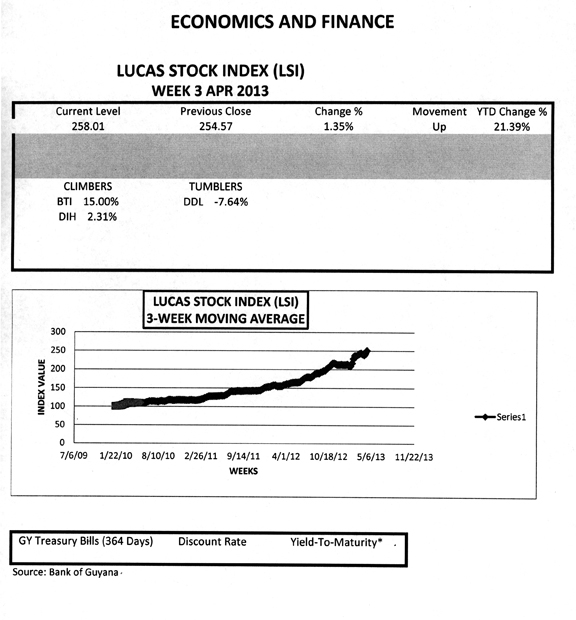Sustained Path
The Guyana economy continues to place too much dependence on gold and remittances. Complacency about the vital structural changes needed to set Guyana on a sustained path of growth could set in with the belief that the streak of uninterrupted growth in the economy had drivers as important as gold and remittances. To think otherwise could undermine the commitment and sacrifice so many Guyanese have made to change their economic and social conditions, and to make things better for their families. While increased recognition is being given to the potential of small businesses, an important sector of the economy, there is no denying that growth was significantly aided by the performance of the gold industry and the ever increasing inflows annually from Guyanese living and working abroad. The performance of gold is significant for several reasons and much time is spent discussing its contribution to the economy in this discussion of the 2013 budget proposal. When measured against several critical macroeconomic variables, gold stands out as a central pillar upon which the current economic growth has occurred.
One important macroeconomic variable is the foreign reserves of Guyana to which gold could be seen as a major contributor. Foreign reserves were reported to be US$825 at the end of 2012. With export receipts of US$716, one can say that gold contribution was equivalent to 86 percent of the value. According to the 2013 budget report before the National Assembly on the performance of the Guyana economy, export receipts amounted to US$1.5 billion in 2012. Export receipts are not a footnote in the economic life of Guyana. They are the means by which the bulk of the income earned in Guyana is obtained since Guyana exports most of what it produces. Those receipts are relied on to import the many consumer goods found in homes, garages and entertainment centres. They are also used to acquire the intermediate goods used in the production process. That gold alone was responsible for 48 percent, nearly half, of the country’s export receipts is in its self interesting.
Magnitude
The magnitude of gold’s contribution to the economy is also seen in its comparative performance against the other major exports. It brought in nearly four times as much foreign currency as rice, nearly five times as much as bauxite, over five times as much as sugar, and in excess of 18 times as much as timber in 2012. The gap between the contribution of gold and the other exports rose steadily from 2008 when gold prices began its surge to the time of the budget proposal currently before the National Assembly.
 The further significance of gold to the Guyana economy is seen in its contribution to gross domestic product or GDP through the level of consumption and investment spending that it makes possible. In 2008, gold accounted for six percent of the goods and services produced in Guyana. At that time, four industries, construction, wholesale and retail, information and communication, and transportation and storage were contributing significantly more than gold to domestic output. Even the expenditure of the administration was contributing more than gold. By 2012, the order of importance had changed. Gold had surpassed construction and the information and communication sectors in significance. It rose sharply and contributed about 10 percent of GDP. It meant that every dollar invested by the industry contributed about 10 cents to government revenues, earnings and consumption last year. Every dollar of output generated close to G$4 in revenue, far more than any other sector. It is not surprising that the distributive trade gets a significant boost and that there was a significant shift in domestic resources towards the gold industry.
The further significance of gold to the Guyana economy is seen in its contribution to gross domestic product or GDP through the level of consumption and investment spending that it makes possible. In 2008, gold accounted for six percent of the goods and services produced in Guyana. At that time, four industries, construction, wholesale and retail, information and communication, and transportation and storage were contributing significantly more than gold to domestic output. Even the expenditure of the administration was contributing more than gold. By 2012, the order of importance had changed. Gold had surpassed construction and the information and communication sectors in significance. It rose sharply and contributed about 10 percent of GDP. It meant that every dollar invested by the industry contributed about 10 cents to government revenues, earnings and consumption last year. Every dollar of output generated close to G$4 in revenue, far more than any other sector. It is not surprising that the distributive trade gets a significant boost and that there was a significant shift in domestic resources towards the gold industry.
Tension
But none of this glitter came from any special incentive spending by the government on behalf of the industry. There was no need since private investment followed the inordinately high price of the commodity. In fact, there has been more tension between the industry and the administration than there has been special support for the industry. The plain reality is that fortunes beyond Guyana’s wildest imagination turned things in its favour. That does not happen quite often given Guyana’s low economic ranking and lack of control over global markets. But, the misfortune of others became Guyana’s fortune. Owing to the loss of confidence in the value of traditional financial assets and asset-backed securities by a major portion of the international community, the price of gold soared and brought rapid amounts of revenue to Guyana.
Instability
The instability of the US dollar, the decline in the value of the major stock markets, the freezing of the credit markets and the revelation of several high profile financial scandals all conspired to reduce confidence among investors across the globe around 2008. As a consequence, several governments started modifying their reserve portfolios, among which was replacing some of their US dollar holdings with gold.
The prospects for robust gold prices were further aided by the policies of the US Federal Reserve which were aimed at stimulating spending in the US economy, and creating employment opportunities.
The unusually large injection of money in the US economy on several occasions spurred fears of inflation among investors between 2008 and 2012. This helped to sustain the high prices for gold, the default commodity for hedging against inflation. It should be obvious that, when fears of inflation begin to subside, the price of gold was likely to fall. How soon, how far, and how fast, the price will fall depend on the expectations of investors of the long-term prospects for low inflation.
Sad Reality
The other major contributor to the Guyana economy is remittances, the injection of money into the Guyana economy from the work of expatriate Guyanese. Remittances accounted for about 20 percent of the income that was generated in Guyana last year. The sad reality about remittances is that it represents a sizable acquisition of income without work, and hence without output. Given that the major portion Guyana’s income come from exports, it is not surprising that gold and remittances accounted for almost half of the income that was earned in Guyana last year. So, the 2013 budget should not seek to overinflate the achievements of the economy. Far too much of the sustainability of positive growth is dependent on things over which the country has very little control. Domestic policy does not influence remittances and it has certainly done little for gold.
Dangerous Position
The administration has failed to explain in the budget how it will deal with the economy if gold prices were to decline and cause investment and employment in the industry to drop. The chain reaction of a likely decline in the price of gold on consumption and investment spending needs to be addressed. In fact, the remark that “[the] world market price for gold remained strong and increased by 6.2 percent to US$1,669 per ounce”, without a caveat, suggests that there is a belief that the attractively high prices will continue unchecked. This is a dangerous position to adopt knowing how easily a decline in the price of the commodity could cause many of the optimistic assumptions about the budget to unravel.
Pleased
All Guyanese, irrespective of their political persuasion, must be pleased about the divine intervention that has left the country with a healthy balance of payments position and high levels of income. But, it would be unwise to believe that that situation would last forever. But this is what the administration thinks judging from the following comment in the budget. “The demonstrated level of investor confidence and anticipated continued high price levels for gold on the world market augur well for the sector”.
Too Optimistic
The scenarios in the budget are too optimistic for a commodity whose demand does not conform to standard market behavior. The global economy is adjusting and soon even the factors that are buoying gold prices will deflate the industry.
Perhaps the National Assembly would wish to keep that in mind as it discusses and decides on the spending priorities and level for the country.
LUCAS STOCK INDEX
The Lucas Stock Index (LSI) continued its climb during trading in the third week of April 2013 with a gain of 1.35 percent. The 148,093 stocks of five companies traded with mixed results. Banks DIH (DIH), which saw 42,187 of its stocks change hands, recorded a gain of 2.31 percent. Gains were also recorded by Guyana Bank for Trade and Industry which saw its value increase by 15 percent on the sale of a modest amount of shares. Demerara Bank Limited (DBL) traded a volume of 31,724 stocks and saw no change in value while Demerara Tobacco Company (DTC) traded a handful of shares, 211, with similar results. Demerara Distillers Limited (DDL) however saw its value plunge 7.64 percent in the sale of 73,346 of its shares.









